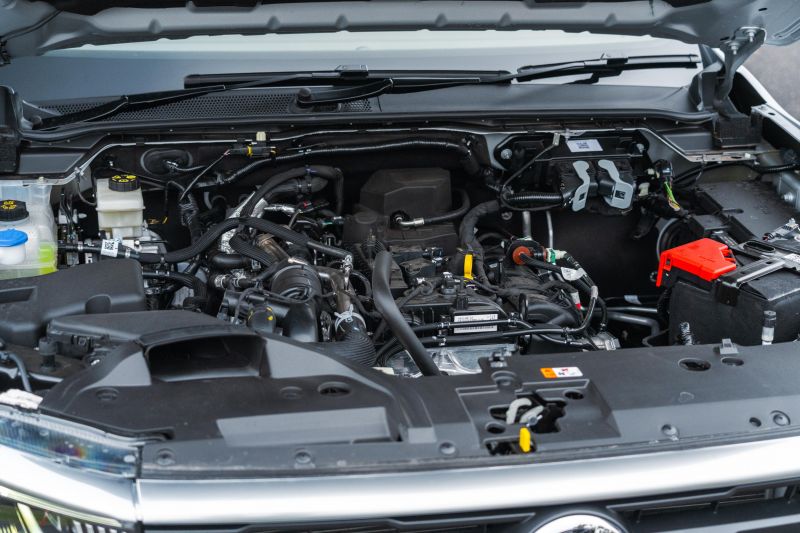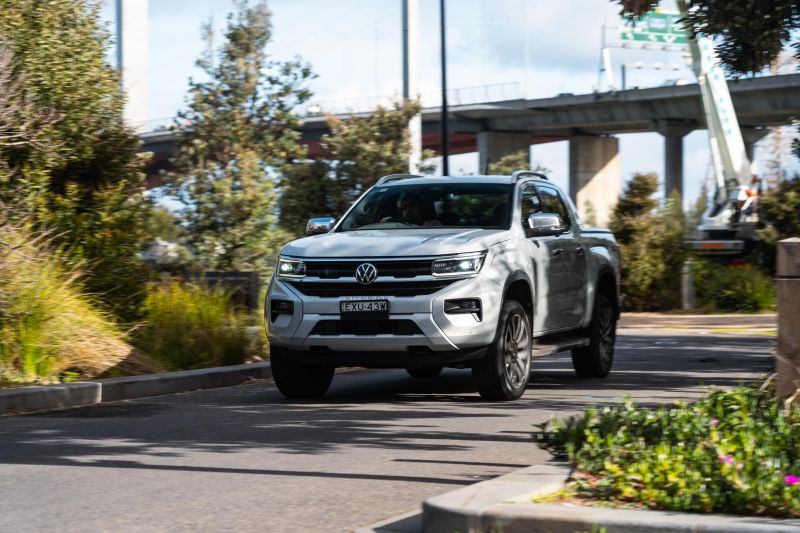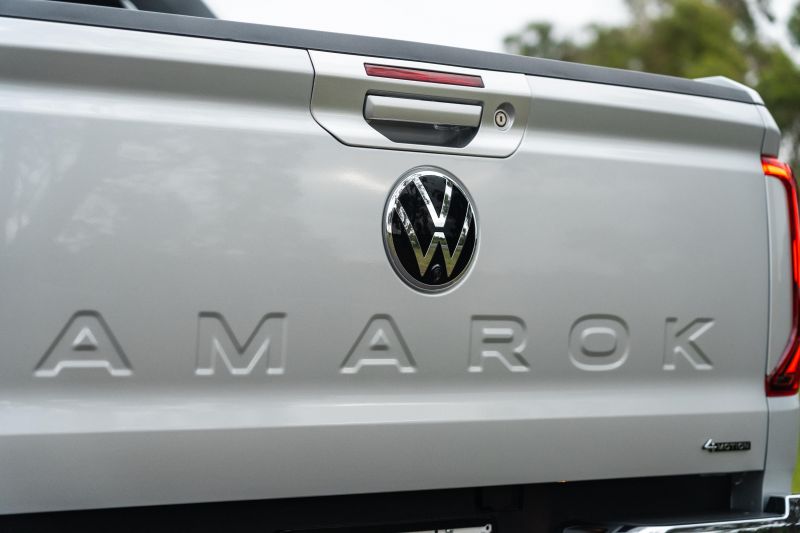There once was a time when petrol engines abounded in the segment the Toyota HiLux and Ford Ranger call home.
That was before a kind of extinction event occurred, and they almost all disappeared apart for some traffic controller-spec HiLuxes and Mitsubishi Tritons, as well as the latest Ford Ranger Raptor (talk about two extremes!)
The first-generation Volkswagen Amarok lost its 2.0-litre turbo-petrol four-cylinder engine around a decade ago, though it was only ever available on low-spec variants.
Now, the second-generation Amarok has touched down and Volkswagen has decided to import a turbocharged 2.3-litre four-cylinder petrol engine as a range-topping powertrain.
There are no longer any V6 Navaras and HiLuxes for it to go up against, however. It essentially has no competition.
That’s in stark contrast with the US, where diesels have never been as popular as here and this segment is full of vehicles with turbo-petrol four-cylinder engines like the Chevrolet Colorado, GMC Canyon, the latest Toyota Tacoma, and the Ford Ranger.
The latter is the Amarok’s twin under the skin, and indeed this 2.3-litre turbo-petrol four is a Ford engine that shares its bones with the 2.3L mill powering the Mustang High Performance and Focus ST.
Yes, this is a hot hatch engine in a ute. It sounds like a strange combination, but does it work?
How much does the Volkswagen Amarok Aventura TSI452 cost?
Volkswagen is offering only one Amarok variant with the 2.3L engine, which is one more than Ford is doing with its Ranger locally.
It’s available exclusively in top-spec Aventura guise, priced from $79,990 before on-road costs. You can get the same trim level but with a 3.0-litre turbo-diesel V6 for the same price.
There are no direct rivals with petrol power, though the more focused Ranger Raptor is $86,790 before on-road costs and packs a twin-turbo petrol V6. If you’re already spending this much money on a ute, you might well be tempted…
What is the Volkswagen Amarok Aventura TSI452 like on the inside?
Picking up the very clearly ex-Ford key fob for the Amarok, you might think this is going to be a Ranger with some Volkswagen badges slapped on, or perhaps an almost imperceptible interior restyling à la the Isuzu D-Max’s transition to a Mazda BT-50.
That couldn’t be further from the truth, with Volkswagen having styled an almost completely unique interior that’s arguably the best-looking in this segment.
But in giving the Amarok a more Volkswagen feel, the German brand has sacrificed some of the more practical touches of its Ford cousin.
Gone is the little nook that can fit a McDonald’s fries packet, as well as the pop-out cup holders on either side of the dash.
Volkswagen’s take on cupholders is less user-friendly than Ford’s. There’s still a pair on the centre console, but they’re a bit small and awkwardly sized.
More bothersome is the removal of the physical climate controls at the base of the touchscreen, which makes adjusting these settings more cumbersome.
To do so, you can use voice commands – which work well, and feature a posh English lady replying to you – or you can press shortcut buttons on the touchscreen.
The Climate button takes you to a menu with the different vent options plus the demister control, while the temperature readout on either side of the screen is what you’ll actually need to press to adjust the temperature. A slider, in turn, pops up.
It’s not as intuitive as a pair of knobs, but at least the shortcut buttons always appear on the screen unlike some cars’ screen-based climate controls.
The physical climate controls were excised in favour of some Volkswagen rocker switches, which take you to different menus like the driver assist settings and drive mode selection.
Despite these shortcut buttons, it can still be a hassle finding functions like auto hold and the camera view, which would require a simple button press in most rivals.
This problem isn’t unique to the Amarok, however, with the Ranger also requiring an additional button press to get to these.
The strengths of Ford’s infotainment system and digital instrument cluster remain, however, and both systems have a natty new skin courtesy of Volkswagen.
Unlike the BT-50/D-Max duo, the Volkswagen uses completely different graphics to its Ford cousin despite having largely the same menu structure.
You’d be forgiven for thinking this was an entirely Volkswagen system, but for the lack of a full-screen map view for the digital cluster.
Touchscreen response times are quick and digital cluster transitions are neat. Everything else in this segment, Ford aside, is dated terribly by the Amarok.
Also outshining the rest of the segment is the Harman Kardon premium sound system, which is perhaps the best we’ve experienced in any ute in this class.
There are plenty of nice details in this cabin. Subtle ambient lighting backgrounds the arm rests, while the front doors are finished largely in soft-touch plastic and leatherette trim, the latter with pleasing stitching details.
This stitching also carries through to the dashboard and, while the leatherette wrapping of the dash isn’t overly thick, it looks premium; likewise, the headliner isn’t as plush as you’ll find in most SUVs this price, but its black finish gives it a more premium look than most utes.
There’s an appealing black/brown colour scheme in the Aventura’s cabin, with brushed metal-look trim on the dashboard and centre console.
We’d like to see some soft-touch trim on the sides of the centre console – the cheaper Triton offers this, and we’d expect nothing less in an SUV at this price point – but otherwise there’s a generally premium feel to this cabin.
Volkswagen has also changed the thing you’ll touch the most: the steering wheel. The German brand knows how to do a good steering wheel – at least when it’s not messing them up with touch-sensitive switchgear – and the Amarok’s is no exception.
It’s a chunky tiller with thick leather wrapping and intuitive switchgear. Cruise control, for example, is activated with ease.
All that’s missing are a pair of paddle shifters behind the wheel. The carryover Ford shifter has a manual shift function, but you change gears with daft plus/minus buttons which American brands seem to love foisting on their vehicles.
Storage is average. The bottle holders in the doors are a bit awkwardly sized, and some larger bottles will stick out.
The centre console bin isn’t particularly large and, while there’s a second glove box of sorts, it won’t fit much stuff. Storage is rounded out with a useless little open nook atop the dashboard. At the base of the centre stack, you’ll find a wireless charging pad and 12V, USB-A and USB-C outlets (one each).
The seats are comfortable, with a good amount of bolstering. They’re finished in leather and feature three-stage heating as well as power adjustment for the driver. The car will also remember your heated seat settings upon start-up.
Open the rear doors and there doesn’t look to be a massive amount of space, particularly considering the size of the vehicle.
The front seatbacks, finished in leatherette, are scooped out, however, so I was able to sit comfortably behind my own seating position. For reference, I’m 180cm tall. Taller occupants might not be quite so comfortable.
There are rear air vents, a fold-down centre armrest, and a 12V outlet, but no USB outlets. If you’re hauling your most precious cargo of all, your children, you’ll find two ISOFIX and two top-tether anchor points for their child seats.
While the Ranger offers FordPass connectivity, allowing you to do things like remotely unlock and start the vehicle or check the trailer lights using a smartphone app, there’s no such capability for the Amarok.
The lined tub is concealed with a remote-controlled roller shutter. Drop the counterbalanced tailgate and roll that shutter back and you’ll find six tie-down points, a 12V outlet, and lighting.
As with the first-generation Amarok, you can fit a Euro pallet between the wheel arches. The tub measures 1544mm long and 1224mm wide.
What’s under the bonnet?
The petrol engine bears the TSI452 name in VW World.
It’s a 2.3-litre turbocharged four-cylinder engine producing 222kW of power at 5900rpm and 452Nm of torque at 3350rpm.
In contrast, the TDI600 3.0-litre turbo-diesel V6 produces 184kW of power at 3250rpm and 600Nm of torque between 1750 and 2250rpm.
Like the turbo-diesel V6, it’s mated with a 10-speed automatic and full-time four-wheel drive. There’s also a locking rear differential.
Both powertrains boast a braked towing capacity of 3500kg, though their payload figures are slightly different: 872kg with the petrol, 858kg with the diesel. If you want a payload of over a tonne, you’ll need to look at the cheaper turbo-diesel V6 Style or Panamericana.
Over a loop comprising a mix of highway and suburban driving, we averaged 9.9L/100km – an identical figure to that which we recorded completing a similar loop in a 2.0-litre Bi-Turbo diesel four-cylinder Ranger. It also happens to be the official combined cycle claim for the Amarok TSI452.
Over the course of a week, this figure rose to 10.2L/100km; this was with plenty of highway driving, but also plenty of Melbourne traffic. For reference, the 3.0-litre turbo-diesel V6’s combined-cycle claim is 8.4L/100km.
The TSI452 does require 95 RON premium unleaded fuel, which undermines its value proposition vis-à-vis the turbo-diesel V6, particularly at a time where 95 RON is pricier than diesel at the pump.
How does the Volkswagen Amarok Aventura TSI452 drive?
I had a real case of cognitive dissonance driving the Amarok, in the nicest possible way.
While petrol V6-powered HiLuxes and the like were once common, this segment has become so staunchly diesel that I had a very strange feeling wash over me as I went to fill up the Amarok.
“Surely this isn’t the right pump?” I asked, before reminding myself that, yes, I must stick that 95 RON nozzle in.
Then there’s the sound it makes at a highway cruise – or the lack of sound, I should say. At highway speeds the cabin is positively serene, without that diesel clatter in the background. That’s not to say an Amarok with, say, the V6 turbo-diesel is unrefined, it’s just this petrol model is so pleasantly hushed it’s almost surreal.
Only the slightest wind rustle around the mirrors intrudes at highway speeds. The turbo-petrol under the bonnet actually has a nice sound to it, and not just “nice compared to a diesel”.
It’s a cracker of an engine too, with plenty of pull. It might be down on torque compared with the V6 turbo-diesel, but it feels rapid off the line and when overtaking.
The transmission shifts smoothly and doesn’t hunt for gears, a complaint that has been levelled at Ford’s 10-speed in the past.
While we don’t usually clamour for paddle shifters in a ute, this is one ute where they’d be a welcome inclusion. Anything is better than those goofy plus/minus buttons on the shifter.
There’s a firmer edge to the Amarok compared with its more softly sprung Ranger cousin, but this doesn’t mean it rides uncomfortably even with its 21-inch alloy wheels.
On the contrary, bumps are dispatched quite adeptly for a ute, and it feels stable and planted on unsurfaced roads. It settles quickly over dips, and exhibits good body control overall.
Only the slightly fidgety feel exhibited by the Amarok on patchwork pavement, something endemic to most utes, reminds you there’s a tub and leaf springs at the back. It never bucks and heaves, though.
We were impressed at how well it absorbed things like expansion joints, which would send impacts through the cabin of other vehicles.
There’s a particular bit of road near our Melbourne office where two different road surfaces meet shortly after a turn, and in myriad utes, cars and SUVs alike a sharp impact is transmitted into the cabin. In the Amarok, we barely felt it.
The steering isn’t Golf GTI sharp, but the weighting is more SUV than ute with a nice, progressive feel.
Honestly, the Amarok Aventura’s dynamics have us wondering what a Volkswagen Everest would be like.
It’s a ute, so despite the tactile steering and gutsy powertrain you’ll reach its dynamic limits quite quickly. The brakes feel doughy and there’s body lean in corners, but this is about as adeptly as a ute can handle short of a Ranger Raptor.
The presence of a full-time four-wheel drive system inspires confidence on slick roads, with a 4A mode allowing power to be sent to all four wheels even when you’re still on pavement.
There’s no Sport mode – not that you need one – though you can select Eco, Tow/Haul, Slippery, Mud, and Sand/Snow modes.
The automatic stop/start system is smoothly calibrated, while the adaptive cruise control and lane centring generally work well. The lane assists don’t feel too intrusive, and the lane centring can handle bends with authority though it’s not perfect.
The car also reminded me on multiple occasions to keep my hands on the steering wheel where they had been the whole time.
The traffic sign recognition works well, while the Matrix LED headlights are stellar. Also top-notch are the cameras, with crisp resolution. The surround-view camera in particular makes this a breeze to park, though we didn’t fiddle around too much with the semi-autonomous parking assist.
Overall, the Amarok is about as SUV-like as a ute can be.
Without whipping out a decibel metre, we’d say it’s the quietest in the segment, while it rides as well as a Ranger if shy of the benchmark Ranger Raptor or a Mazda BT-50 with its optional suspension upgrade.
What do you get?
The Aventura has a unique look compared to other Amarok models, with chrome trim on the front and rear bumpers, mirrors and door handles, a rear sailplane and an electric roller cover.
It also features 21-inch alloy wheels that fill the arches out nicely.
Inside, it also features leather upholstery, leatherette trim on the dashboard, and an eight-speaker Harman Kardon sound system, features shared with the slightly cheaper Panamericana.
Otherwise, its equipment list mirrors the more affordable Style, including:
- Matrix LED headlights
- Tub liner
- Keyless entry and start
- Power driver’s seat
- Heated front seats
- 12-inch touchscreen infotainment system
- 12-inch digital instrument cluster
- Dual-zone climate control
- Ambient lighting
- Semi-automatic parking assist
Other features found in lesser Amaroks comprise:
- Wireless Apple CarPlay, Android Auto
- DAB digital radio
- Leather-wrapped shifter, steering wheel
- Electronic park brake
- Dual-zone climate control
- Rain-sensing wipers
- Automatic headlights
- LED fog lights
- Remote locking tailgate
Is the Volkswagen Amarok safe?
The Amarok has a five-star ANCAP safety rating based on Euro NCAP testing conducted in 2022.
It received an adult occupant protection rating of 86 per cent, a child occupant protection rating of 93 per cent, a vulnerable road user protection rating of 74 per cent, and a safety assist rating of 83 per cent.
All models come standard with:
- 9 airbags
- Autonomous emergency braking (AEB)
- Adaptive cruise control
- Lane-keep assist
- Speed sign recognition
- Multi-collision braking
- Reversing camera
- Rear parking sensors
Amarok Life and up feature blind-spot monitoring and front parking sensors, while Style and up receive a surround-view camera.
Notably, the new Amarok features curtain airbags that extend into the second row. Its predecessor lacked these.
How much does the Volkswagen Amarok Aventura TSI452 cost to run?
The Amarok is backed by a five-year, unlimited-kilometre warranty.
Regardless of powertrain, the Amarok costs the same to maintain and has servicing intervals of 12 months or 15,000km.
The first five services are capped at $329, $329, $414, $329 and $400, or $1801 all up. You also have the option to pay $1800 for a five-year pre-paid Care Plan.
CarExpert’s Take on the Volkswagen Amarok Aventura TSI452
I knew going into this that the petrol-powered Amarok was going to be interesting, and it didn’t disappoint.
This is an impressively refined ute and, though it lacks the sheer stump-pulling torque of the turbo-diesel V6 on paper, it has plenty of grunt.
Indeed, this engine imbues the Amarok with a less ute-like feel. It’s hushed most of the time, but has a nice engine note when you punch it, while its fuel economy is decent for a vehicle this size.
The usual second-generation Amarok strengths also apply with the Aventura TSI452, from its attractive styling inside and out to its comfortable ride.
It’s let down only by some design choices inside the cabin which, while in service of a more attractive interior, have affected usability.
It’s also a pity you have to step all the way up to the top-spec Aventura to get this engine. We’re not sure the 2.3T engine is going to be a significant seller given just how much ute buyers have come to embrace diesels, but it’s a genuinely good powertrain and we’d like to see it in, say, the more affordable Style grade.
This or the 3.0-litre turbo-diesel V6? That’s a tough question, as both powertrains are excellent. If you choose the 2.3T, however, you’ll be getting something just a little bit different, ideal if you don’t like to follow the herd.
Click the images for the full gallery


























